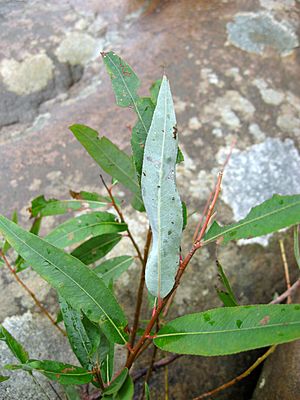Coastal plain willow facts for kids
Quick facts for kids Coastal plain willow |
|
|---|---|
 |
|
| Conservation status | |
| Scientific classification | |
| Genus: |
Salix
|
| Species: |
caroliniana
|
 |
|
| Generalized natural range | |
Salix caroliniana, also known as the coastal plain willow, is a type of shrub or small tree. You can find it growing naturally in the southeastern United States, Mexico, parts of Central America, and the Caribbean. This plant loves wet places, like wetlands, and often grows right out of the water in areas like the Everglades.
Contents
About the Coastal Plain Willow
This willow is special because it needs a lot of water to grow. It's called an "obligate wetland species" because it must live in wet environments. In places like the Everglades, it grows as an "emergent species," meaning it stands tall out of the water.
Fires are common in some of the areas where this willow lives. If there are no fires, the coastal plain willow can turn grassy wetlands into forests. Even though fires can kill the larger parts of the plant above ground, the willow quickly grows back from its roots. This means that after a fire, a willow tree might become a willow shrub, but the plant is still there.
When It Flowers
The coastal plain willow blooms in early spring. Its flowers appear either before or at the same time as its leaves. For example, in Alachua County, Florida, in 1982, people saw it flowering during February and March.
Its Discovery
A French scientist named André Michaux was the first person to describe this plant. He wrote about it in 1803 in his book called Flora Boreali-Americana.
Importance to Animals
The male flowers of the coastal plain willow provide a lot of pollen for bees in the springtime. This plant is also a very important home and food source for the young (larvae) of many different moths and butterflies.
Some of the insects that use the coastal plain willow are:
- the black-waved flannel moth
- the blinded sphinx
- the cecropia moth
- the elm sphinx
- the imperial moth
- the Io moth
- the modest sphinx
- the mourning cloak butterfly
- the polyphemus moth
- the promethea moth
- the red-spotted purple butterfly
- and the viceroy butterfly
See also
 In Spanish: Salix caroliniana para niños
In Spanish: Salix caroliniana para niños


